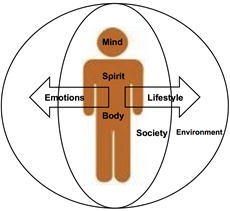The balance between risk factors and protective factors

This balance determines whether an acute problem progresses to chronic pain or not. By reducing risk factors for chronic pain and improving protective factors, the potential for delayed recovery is decreased and recovery enhanced. Here are a list of some of the factors that can play a role in the balance between health and wellness. These factors need to be assessed prior to any treatment for a pain condition. The extent to which these factors are changed will be the difference between continued suffering and being pain free.
| Risk factors and protective factors within our lives play a significant role in the balance between health and wellness. A human systems approach to preventing chronic pain includes factors in in the seven realms of our lives including the body, lifestyle, emotions, society, spirit, mind, and environment. (To facilitate remembering, the acronym is BLESS ME) | |||
|---|---|---|---|
| Realm | Description | Protective Factors | Risk Factors |
| Body | Physical and physiological aspects of our body. | Balanced relaxed posture, stretching, strengthening, and conditioning exercise | Poor posture, tight weak muscles, hypo- or hyper-mobile joints, poor conditioning, injury, genetic risk, and co-morbid conditions. |
| Lifestyle | Lifestyle behaviors that we do on a regular basis. | Protective diet, steady pacing, being active, regular sleep, low risk behaviors, and compliance with protective actions | Poor diet, sedentary life, prolonged sitting, poor sleep, hurrying/ rushed, repetitive strain, high-risk behaviors, chemical use. |
| Emotions | Personal expressions of the feelings that we experience | Sustained positive primary, secondary, and tertiary emotions such as feelings of joy, excitement, confidence, optimism, happiness, and contentment | Prolonged negative emotional experiences such as anger, anxiety, sadness, and depression. |
| Society | People that surround us and interact with us regularly. | Positive relationships, social support for health, regularly helping others, i.e. family, friends, colleagues, community. | Poor relationships, routine conflict, abuse, post-traumatic stress, low social support, secondary and tertiary gain |
| Spirit | Beliefs, faith, and passion that maintains us | Self-compassion, self-esteem, purpose, direction, beliefs, and faith, and hope | Stress, burnout, disbelief, cynicism, doubt, helpless, hopelessness |
| Mind | Thoughts and cognition that we experience | Whole understanding, resilience, self-efficacy and self-control, accepting responsibility, realistic expectations, and active coping. | Ignorance of problem, low resilience, low self-efficacy/ control, deny responsibility, poor compliance, unrealistic expectations, and passive coping. |
| Environment | Physical environment both natural and man-made and our interaction with it | Clean, organized, safe environment and an approach that protective, cautious, and careful. | Living within an unclean, chaotic, and disorganized environment with an approach that is negligent, dangerous, increase risk of injury and accident |
Seven Realms Assessment.

As part of the CPR-Net, the seven realms assessment can be used by health professionals to help people prevent chronic pain through changes in the 7 realms of their life. The assessment has 3 parts including;
- Measure severity of pain and its impact,
- Screen for risk and protective factors.
- Identify goals for the patient to change.
This assessment found at https://www.biomedicalmetrics.com/cgi-bin/home.cgi is designed to help health professionals better understand and personalized a self-management program to prevent chronic pain. This program incorporates both research and clinical experience in determining what strategies are successful in preventing chronic pain. There are three parts to the assessment.
- Assess your pain This assessment can help people understand how to assess areas of pain and its severity and impact. It can also be able to compare the prevalence and severity of your pain areas to others around the world who are also taking this assessment as well as to determine progress.
- Who are you?This assessment helps people understand what are their risk factors (vices), protective factors (virtues), and strategies are for preventing chronic pain in each of the seven realms. Research has suggested that there are many factors to either help prevent chronic pain in the future or lead a person down the path to chronic pain. This assessment will identify these factors and compare them to that of others who have taken this assessment.
- Create yourself Wellness is not just about managing illness but also enhancing health. People with pain conditions need to imagine how they would like to be and create a portrait that describes the best of them in health and wellness. Research has suggested that there are many small changes within each of the seven realms that can be made to enhance health. This assessment will help determine what activities can be done to help prevent chronic pain and achieve a better life.

